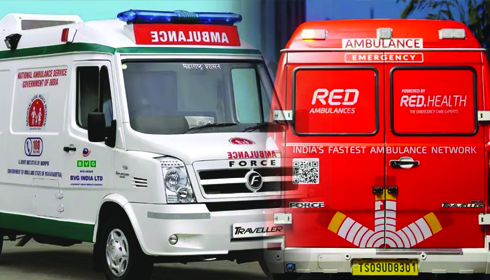
India needs public private partnership to bridge the rural-urban divide of rural-urban emergency patient transportation
The stakes are higher than ever in a country where prompt emergency transport can mean the difference between life and death. There is a critical need for improvements in emergency patient transportation throughout India, as evidenced by the over 80% of patients who do not obtain prompt medical assistance during emergencies. The government's efforts, the critical played by the private sector can help bridge the urgent need to address the differences ins in emergency healthcare access between urban and rural areas, thereby ushering in equitable health for every citizens.
India has a startling 18.9 road mortality rate per 100,000 inhabitants, which is far higher than the global average. One significant factor in these deaths the delay in seeking emergency medical attention. According to some recent studies, rural areas have significantly slower ambulance response times. Some patients may have to wait up to 30 minutes, which can be fatal for disorders like heart attacks and strokes. Urban areas often experience resource constraints in public healthcare systems, exacerbating the situation.
Though State governments have implemented various efforts to enhance emergency services, with many areas, the 108 emergency service has been an invaluable lifeline, offering prompt medical attention, they are simply inadequate especially in the remote regions. Tamil Nadu and Kerala, for example, are well known for their creative techniques. While Tamil Nadu concentrates on first responder training to provide high-quality care, Kerala has successfully incorporated technology into its EMS to enable faster response times.
however, state governments' funding and collaborations with non-governmental organisations (NGOs) have reinforced these emergency service frameworks, demonstrating a dedication to enhancing healthcare outcomes and accessibility.
The central government launched national initiatives like the Pradhan Mantri Jan Arogya Yojana (PM-JAY) to increase access to emergency services and other forms of healthcare. To guarantee a unified emergency response system, the Ministry of Health has put in place regulations that standardise services across state lines. State and federal government coordination is necessary to exchange best practices and put into place efficient emergency care programmes across the country.
Private entities like RED Health are assuming critical roles in bridging gap of emergency transportation system. RED Health, the first JCI-accredited medical transport firm in Asia, runs more than 5,000 ambulances in more than 20 Indian cities. When it comes to offering quick response services, they have advanced significantly.
"Our mission at RED Health is to fundamentally transform the landscape of emergency medical services in India," said Prabhdeep Singh, the company's founder and CEO. When an emergency arises, every second counts, and our staff is unwaveringly committed to improving our patients' overall health outcomes in addition to saving lives. This dedication to providing prompt and dependable care is an example of how the private sector's engagement may significantly improve emergency healthcare.
Furthermore, RED Health incorporates cutting-edge technology into its operations to enable faster ambulance dispatch and real-time tracking, which lowers response times. This innovation is essential to guaranteeing prompt care for patients in rural and urban locations alike.
The availability of emergency services varies significantly between urban and rural locations. Although EMS is frequently readily available in urban areas, there is a major scarcity in rural areas. Mobile clinics, which may offer care in remote locations, and telemedicine, which can instantly connect patients with medical professionals, are two suggested options to close this gap.
Another practical option is to establish community-based emergency response teams, which enable the local populace to react quickly to crises. Furthermore, it is imperative that government initiatives aimed at improving rural healthcare receive priority in order to improve accessibility and guarantee prompt interventions.
Establishing a well-rounded emergency medical care system that incorporates both public and private services is necessary. Maintaining high-quality care while guaranteeing cost must be the key goal of this plan. Future plans for sustainable emergency care models ought to take into account a wide range of demographics in order to promote a more robust healthcare system.
Government agencies working with commercial organisations like RED Health can improve service delivery and guarantee that people in both urban and rural areas have equal access to emergency care.
Improving the transportation of emergency patients is crucial to saving lives in India. As the importance of prompt intervention becomes increasingly apparent, it is imperative that the public, business, and community sectors continue to work together. "Expanding these services is imperative... ultimately saving more lives and enhancing the quality of care across the board," stressed RED Health's Dr. Tausif Thangalvadi.
In order to protect each citizen's health, we must adopt an inclusive strategy and make sure that emergency services are available to everyone, everywhere. India can go closer to attaining health equity for its diverse people by bridging the gap between rural and urban emergency healthcare systems.